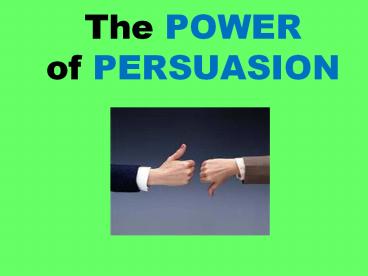The POWER of PERSUASION - PowerPoint PPT Presentation
1 / 25
Title:
The POWER of PERSUASION
Description:
Title: CAHSEE WRITING REVIEW Author: Educational Technology Last modified by: LBUSD Created Date: 9/14/2004 3:39:36 AM Document presentation format – PowerPoint PPT presentation
Number of Views:86
Avg rating:3.0/5.0
Title: The POWER of PERSUASION
1
The POWER of PERSUASION
2
According to Wikipedia
- Persuasion is a form of social influence. It is
the process of guiding oneself or another toward
the adoption of an idea, attitude, or action by
rational and symbolic (though not always logical)
means.
3
The Persuasive Writer
- Takes a position for or against an
- issue or topic which people
- disagree
- Convinces the opposition to
- believe what the writer believes
4
Purpose
- Persuade readers to care about your issue and
do something about it.
5
Persuasive Topics
- Easier Topics
- Best restaurant?
- Best hobby?
- Best sport?
- Best television show?
- Best book?
- Best actor/actress?
- Best radio station?
- Trickier Topics
- Consequences for Cheating or Bullying
- Passing students without passing grades
- Healthier food at schools
- Local community issues
6
Know your audience!
- The audience is the person or group of people you
are trying to convince. - Your word choice and approach will vary depending
upon your audience.
7
Brainstorm both sides
- What is your position?
- Why?
- What is the opposing sides position?
- Why?
8
Plan the Counterarguments
- Identify the best reasoning that your opposition
has for believing what they do. These are their
arguments! - Brainstorm convincing arguments to change their
thinking in these areas. These are your
counterarguments!
9
Effective Reasoning Devices
- Appeal to logic through reasoning
- Appeal to emotion
- Ethical arguments/beliefs
- Personal anecdotes (stories)
- Case study (research)
- Analogy (comparison)
10
Practice persuasion
- TOPIC
- Should animals be used for
- experimentation?
- POSITION
- Animals should NOT be used
- for experimentation.
11
Appeal to logic
- There are other methods to test products and
achieve the same results.
12
Appeal to emotion
- Does any animal have to experience pain in order
for us to have a better shampoo?
13
Ethical arguments/beliefs
- Shouldnt all living creatures be treated
humanely?
14
Personal anecdotes
- Can you imagine your own pet suffering? Animals
of all sorts are tested in order for companies to
develop better products? If you wouldnt allow
your animal to suffer, why should others?
15
Case study
- Over 5,000 bunny rabbits were maimed or killed
during the research process to develop a certain
store brand shampoo.
16
Analogy
- Just because animals cant verbalize their pain
doesnt mean they dont experience emotion. Its
like a baby who cant tell you what is wrong but
can still cry to express how she feels.
17
PERSUASIVE ESSAY 5 PARAGRAPH FORMAT
- Paragraph 1 Introduction-attention grabber,
- background, and
position statement - Paragraph 2 Position Support Reason 1
- and explanation
- Paragraph 3 Position Support Reason 2
- and explanation
- Paragraph 4 Counterarguments and rebuttals
- Paragraph 5. Conclusion- Restate your
position - and call the
audience to action.
18
- 5 Paragraph Essay Format
Introduction
Supportive Reason 1 and Explanation
Supportive Reason 2 and Explanation
Counterarguments Rebuttals
Conclusion
19
Introduction
- Attention Grabber (question, anecdote, quotation,
statistic, startling statement) - 2) Background information
- 3) Position Statement
20
Paragraph 2
- First reason of support
- for your position.
- 2) Explanation and support
21
Paragraph 3
- Second reason of support
- for your position.
- 2) Explanation and support
22
Paragraph 4
- List two counterarguments of the
- opposition.
- 2) Give logical rebuttals to address their
concerns.
23
Conclusion
- Restate Position
- 2) Restate supportive reasons
- 3) Call the audience to action
24
Calls to Action
- Be reasonable and specific.
- Dont just tell audience to change mind or make a
weak request. - Specifically tell the audience to do something.
25
Common Calls for Action
- Possibilities
- Attend a meeting.
- Write an important person of the cause.
- Fill out a survey.
- Volunteer to
- 5) Do SOMETHING!































